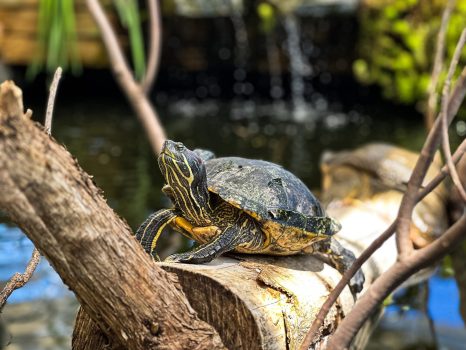Red-Eared Slider
Common Name: Red-Eared Slider
Scientific Name: Trachemys scripta elegans
Names: N/A
Locations: Whitby, Vaughan and London

Diet
Red-Eared Sliders are omnivores, with a diet that includes aquatic plants, algae, insects, small fish, crustaceans, and occasionally small amphibians or reptiles.
Average lifespan
Red-Eared Sliders can live for 20 to 30 years or more with proper care.
Size
Adult Red-Eared Sliders typically reach lengths of 15 to 30 centimeters (6 to 12 inches), with females generally being larger than males.
Weight
Adult Red-Eared Sliders can weigh between 0.5 to 2 kilograms (1 to 4.4 pounds), depending on age, sex, and diet.
About
Red-Eared Sliders are a popular species of semi-aquatic turtle native to the southern United States and northern Mexico. They are named for the distinctive red stripe behind their eyes, which contrasts with their olive-green or brown carapace.
Size and behavior
Red-Eared Sliders are well-adapted to both terrestrial and aquatic habitats. They spend much of their time basking on rocks or logs near the water’s edge but are excellent swimmers and can stay submerged for long periods. They are relatively social and can often be found basking in groups.
Diet and nutrition
Red-Eared Sliders are opportunistic feeders, consuming a wide variety of plant and animal matter. Their diet should include a balance of protein, vegetables, and fruits to ensure proper nutrition. Commercial turtle pellets, leafy greens, insects, and small fish are commonly offered foods.
Conservation status
While Red-Eared Sliders are not currently considered threatened or endangered, they have been introduced to many parts of the world outside their native range, where they can outcompete and threaten native turtle species. In some areas, they are considered invasive species and can disrupt local ecosystems.
Fun fact
Red-Eared Sliders are known for their ability to bask in the sun for extended periods. Basking helps regulate their body temperature and aids in digestion. They often stretch out their limbs and tilt their shells to maximize exposure to the sun’s warmth.
Call or visit your local Reptilia Facility to learn how you can adopt one of these amazing reptiles.










